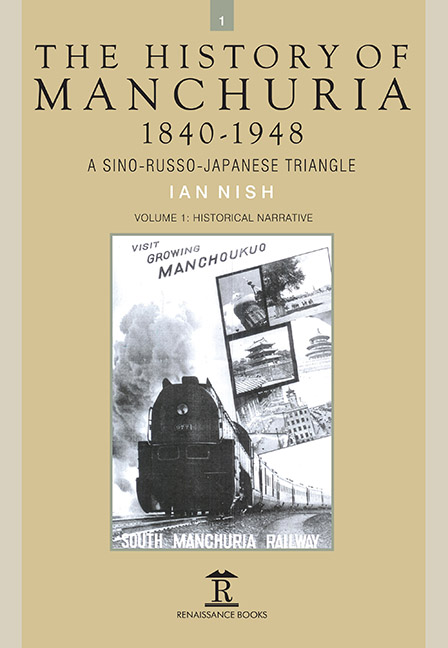Book contents
- Frontmatter
- Dedication
- Contents
- Preface
- Acknowledgements
- Name Conventions
- List of Abbreviations
- List of Maps
- Chapter One Manchuria and Russian Ambition, 1840s–1890s
- Chapter Two Sino-Japanese War and After, 1894–1900
- Chapter Three Prelude to the Russo-Japanese War, 1900–1905
- Chapter Four Railways, Reforms and Revolutions, 1906–1914
- Chapter Five Wartime Turmoil in Manchuria, 1915–1922
- Chapter Six Chang Tso-Lin’s Manchuria, 1922–28
- Chapter Seven Chinese Nationalism and Foreign Railways, 1929–1931
- Chapter Eight Lytton Commission in Manchuria, 1931–1932
- Chapter Nine Manchukuo: From Republic to Empire, 1933–1937
- Chapter Ten A Decade of Wars, 1938–1948
- Epilogue
- Map
- Select Bibliography
- Index
- Volume 2: Select Primary Sources
- Miscellaneous Frontmatter
- Dedication
- Miscellaneous Frontmatter
- Chapter 1 1840–1894
- Chapter 2 1895–1899
- Chapter 3 1900–1905
- Chapter 4 1905–1914
- Chapter 5 1915–1922
- Chapter 6 1922–1928
- Chapter 7 1929–1931
- Chapter 8 1931–1932
- Chapter 9 1933–1937
- Chapter 10 1938–1948
- Apendix Appeal by the Chinese Government
Chapter 4 - 1905–1914
Published online by Cambridge University Press: 18 November 2023
- Frontmatter
- Dedication
- Contents
- Preface
- Acknowledgements
- Name Conventions
- List of Abbreviations
- List of Maps
- Chapter One Manchuria and Russian Ambition, 1840s–1890s
- Chapter Two Sino-Japanese War and After, 1894–1900
- Chapter Three Prelude to the Russo-Japanese War, 1900–1905
- Chapter Four Railways, Reforms and Revolutions, 1906–1914
- Chapter Five Wartime Turmoil in Manchuria, 1915–1922
- Chapter Six Chang Tso-Lin’s Manchuria, 1922–28
- Chapter Seven Chinese Nationalism and Foreign Railways, 1929–1931
- Chapter Eight Lytton Commission in Manchuria, 1931–1932
- Chapter Nine Manchukuo: From Republic to Empire, 1933–1937
- Chapter Ten A Decade of Wars, 1938–1948
- Epilogue
- Map
- Select Bibliography
- Index
- Volume 2: Select Primary Sources
- Miscellaneous Frontmatter
- Dedication
- Miscellaneous Frontmatter
- Chapter 1 1840–1894
- Chapter 2 1895–1899
- Chapter 3 1900–1905
- Chapter 4 1905–1914
- Chapter 5 1915–1922
- Chapter 6 1922–1928
- Chapter 7 1929–1931
- Chapter 8 1931–1932
- Chapter 9 1933–1937
- Chapter 10 1938–1948
- Apendix Appeal by the Chinese Government
Summary
As the theatre of the Russo-Japanese war, Manchuria has had a great deal ol attention drawn to it. At the same time that its immense possibilities for trade were pointed out great hopes of immediate and great forward development, that have scarcely fructified, were entertained. The principal goods coming into Mukden are foreign yarn, kerosene oil, flour, and piece goods, which come by way of Newchwang; grain from the neighbouring districts and from Hai Cheng and Kai Ping; coal from the Eastern hills; native cloth from Shantung and Chili; native opium from the province of Kirin; foreign opium from Newchwang; tobacco leaf from Kirin and Tieh-ling and the surrounding districts; and raw cotton, cotton fabrics, sea products, papers, cigars, and cigarettes from japan and by way of Tairen.
Manchurian trade has improved, though all that was anticipated when the war was concluded has not eventuated. japan has benefited, but she has certainly not done so to the extent that one would have anticipated with the opportunities she had. Two large well-known Japanese firms had opened. There were plenty of petty traders, contractors, barbers, storekeepers, but except in numbers they did not bulk greatly. It may be that the lack of capital accounts for part of this, but there were not wanting those who attribute the fact that no more had been achieved to lack of business capabilities. The larger firms show these qualities often in a conspicuous way, but the bulk hardly exhibit them to a degree that brings an adequate reward for the blood and treasure that have been expended. It is evident that the Japanese have captured none of the Chinese trade in Manchuria; Chinese are not to be beaten on their own ground any more than they were to be ousted from the bean-cake business at Newchwang to South China, into which trade the Japanese essayed to enter, but had to relinquish the attempt in a very few months. It is true that by means of exhibitions at Mukden, Antung, and elsewhere, and by advertising means, much has been done to push Japanese goods; but even here the Chinese threaten to go one better at Mukden.
- Type
- Chapter
- Information
- The History of Manchuria, 1840-1948A Sino-Russo-Japanese Triangle, pp. 50 - 73Publisher: Amsterdam University PressPrint publication year: 2016

